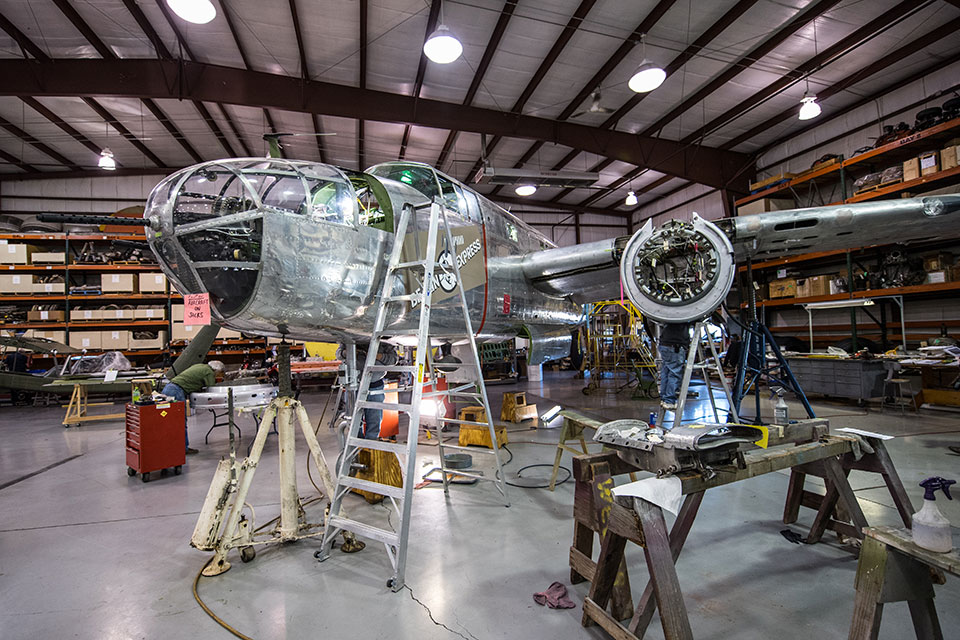B-25 Project Reaches Fundraising Goal
EAA’s targeted fundraising effort to support the restoration of its North American B-25 Mitchell has reached its current goal of $400,000 after a successful 2017 campaign.
“The project really came together at the end of the year, which is the way you want it to end,” said Ken Strmiska, EAA’s vice president of philanthropy and donor stewardship. “What we were aiming for was to raise $400,000 by December 31st. Right about that time, we received a very generous donation that helped us to reach the goal.”
EAA’s B-25, Berlin Express, has been undergoing an extensive restoration in order to return it to flying condition. The airplane was delivered to the U.S. Army Air Forces in 1943, and changed hands several times after World War II before coming to EAA in the early 1970s. The airplane is best known for its role in the 1970 film Catch-22, a dark satire about a B-25 squadron serving in the Mediterranean theater. EAA flew the airplane for several years before it was damaged in a landing accident, cosmetically repaired, and then placed on display in the EAA Aviation Museum for a few decades. In 2015, it was decided to restore the airplane with the goal of using it to honor veterans and promote educational outreach as EAA does with its B-17, Aluminum Overcast.
“We can’t do this by ourselves, it’s a team effort,” Strmiska said. “That goes for the people who’ve been volunteering for the past few years on this aircraft and to everybody who gave a donation. These things don’t come together without a thousand hands doing a little bit here and there to make it work. That’s the beauty of this project, and, frankly, that’s the beauty of EAA.”
Under the guidance of John Hopkins, EAA’s manager of aircraft maintenance, an army of volunteers has been working on the project since January 2015. Organized by Kirk Fjetland, EAA 867374, president of EAA Chapter 237 in Blaine, Minnesota, regular work parties consist of several members of Chapter 237, as well as volunteers from other chapters from around the country.
The volunteers’ role in the project has been vital to its ongoing success.
“The chapter, a couple of years ago, did the whole nose over in Minnesota for us, so that was very helpful,” Hopkins said. “That was really the kick-start to the whole project — the chapter taking some ownership of it and getting started on it, because we didn’t have the time or the resources to do it here. It’s been fun.”
The money raised so far has directly supported the restoration efforts, including overhauling both engines, which are expected to be completed by Anderson Aeromotive in Idaho and shipped back to EAA by early March. Other work that’s been done recently includes removing and refurbishing the landing gear and prepping it for reinstallation, and finishing the interior, including the seating areas.
“I think we’re going to come in on or under budget,” Hopkins said. “We should have enough reserve cash left over to purchase an extra propeller and an extra engine when the time comes that will give us a little extra cushion as the airplane goes into service.
Strmiska also stressed the importance of having that cushion.
“It’s always good to have a reserve fund because you never know what is going to happen to the aircraft — when an engine’s going to go, or when something mechanical is going to go,” he said. “By having a little bit of a reserve we’ll be assured and the community will be assured that the aircraft is going to be flying for a long time.”
If you’d like to support this project, you can find ways to contribute at www.EAA.org/B-25.
For more on the restoration of the Berlin Express, see “Restoring a Mighty Mitchell” in the June 2017 issue of EAA Sport Aviation magazine.

